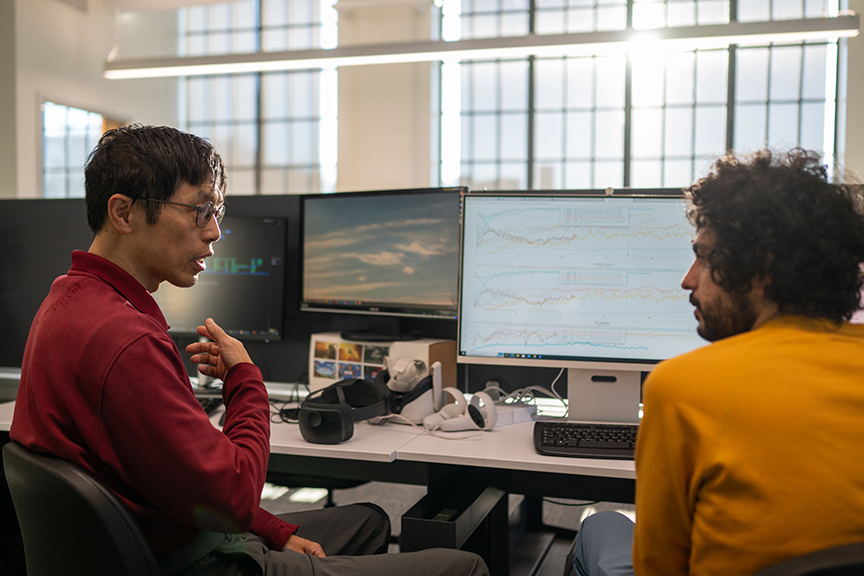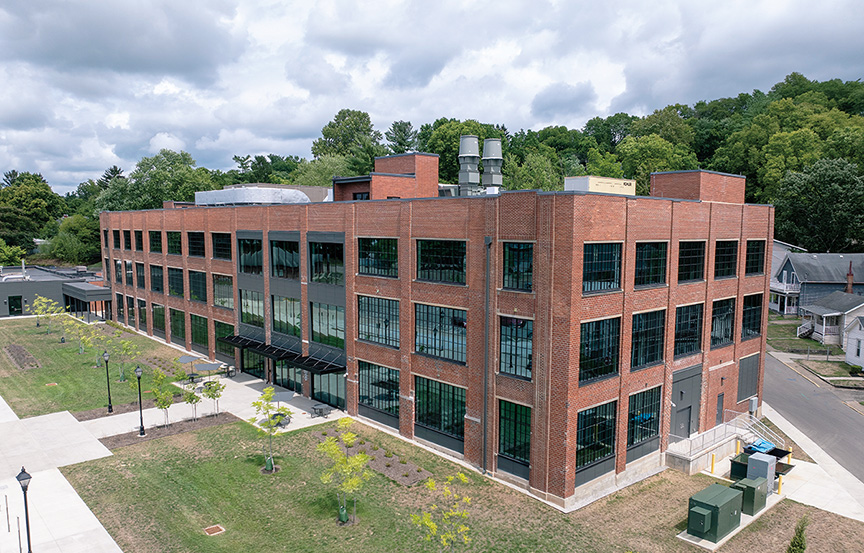The University’s Union Green is home to the new Russ Research Opportunity Center (opens in a new window) (RROC), a beacon of engineering and science collaboration that has replaced the West Union Street Office Center. This state-of-the-art facility, endowed by the generosity of Fritz J. and Dolores H. Russ (opens in a new window), signals the start of a new era of interdisciplinary research (opens in a new window) within the Russ College of Engineering and Technology (opens in a new window).
The RROC stands as a testament to the University’s commitment to supporting its recent R1 classification (opens in a new window) by the Carnegie Classification of Institutions of Higher Education, which acknowledges very high research activity, with researchers at the forefront of their respective fields dedicated to finding solutions to pressing societal issues.
The building also brings together under one roof a large portion of Russ College’s research operations, versus the campus-wide spread of facilities in years past. As researchers eagerly settle into this shared space, they are redefining the University’s research landscape and propelling it toward a greater academic impact.
The RROC was made possible by a transformational $124 million estate gift, the largest in OHIO’s history, by Fritz and Dolores Russ in 2008; fittingly, it was named in their honor.
“Once the Russ gift came along, we had the opportunity to consolidate more of our research under one facility to enhance our current and future research capacity,” says Eric Steinberg (opens in a new window), associate dean for research and graduate education in Russ College. “It is also an excellent recruiting mechanism for future faculty and students.”
The gift was directed with a specific purpose: to enhance centers of excellence in research, adds Patrick Fox (opens in a new window), dean of Russ College. “This is a milestone in our college’s history,” he says. “As a multidisciplinary, state-of-the-art research incubator, the opportunities provided by the RROC for research excellence—including high-level, meaningful collaborations—are truly exciting.”
One example of such collaboration comes from AEP Ohio (opens in a new window), which in May awarded Russ College a $100,000 grant (opens in a new window) via its American Electric Power Foundation (opens in a new window). In recognition of this support, the RROC’s High-Temperature Chemical Synthesis and Energy Production Lab, part of the Institute for Sustainable Energy and the Environment (opens in a new window), will be named for the AEP Foundation. This lab, directed by Jason Trembly (opens in a new window), Russ professor of mechanical engineering, aims to pioneer sustainable technologies for natural and renewable energy sources, reflecting the shared vision of the University and partners like AEP Ohio.
“The generosity of the AEP Foundation is truly appreciated,” says Fox. “This major gift marks the first named research space within our new RROC building, and for it to recognize the American Electric Power Foundation, one of our most valued partners, makes this event even more significant.” The newly named lab and others in the RROC are designed to encourage interdisciplinary projects, enhancing research capabilities and educational experiences.

Russ College’s newest facilities on Union Green are designed to encourage collaboration within and between disciplines. Photo by Ben Wirtz Seigel, BSVC '02
Software engineering professor Chang Liu (opens in a new window) appreciates how the communal spaces in the RROC foster an environment of collaboration on a smaller scale, too.
“This is a wonderful space for students to work together,” he says. “This just encourages people to sit together and collaborate on creative solutions to challenges.”
Abigail Paul (opens in a new window), a graduate student in the chemical engineering department, echoes that sentiment. “It’s going to be really nice to be able to see people who are doing similar research,” she says. “We’ll be able to bounce ideas off of people in a much easier way.”
Paul was one of the first students to begin moving into the space to continue her research in electrochemical engineering. “My work [looks] at utilizing a natural resource that’s really abundant in this area: coal. ... The main focus of my work is taking coal [and] turning it into a coal-derived graphite that can then be used in a lithium-ion battery,” Paul says. “Any of those batteries that you use in your cellphone, your computer, electric vehicles—they’re all lithium-ion batteries, primarily.”
Paul adds that graphite is a critical material that is not abundant in the United States, so her research aims to create more using material that is abundant by transforming coal into a cleaner energy source.
“I’m working on developing a potential feedstock for graphite that can be used in these newer technologies,” Paul says. “Specifically, electric vehicles are what we’re really focused on.”
Stocker Center (opens in a new window) felt crowded with researchers, in Paul’s opinion, so she’s excited to move into a building that is ready to be tailored to researchers’ needs.

An aerial view of the new Russ Research Opportunity Center on West Union Street. Photo by Ben Wirtz Siegel, BSVC ’02
That flexibility in space is by design, allowing for evolution in use. The recent growth in research at Russ College has made special adaptability essential, so the building’s interior construction allows research spaces to be easily reconfigured without major renovations.
“The facility will have immense flexibility, allowing it to adapt to the continuously evolving nature of research so it can always meet the needs of faculty and their ongoing studies,” Steinberg says.
This, in turn, will foster further growth opportunities for Russ College and its stakeholders. “The space allows us to expand our research profile and programming, pivot our research as necessary, and recruit new faculty,” says Trembly. “It provides both finished space for current researchers and shelf space for future expansion.”
Fox emphasizes the significance of providing researchers with a refined and renovated space that fosters growth and collaboration.
“The RROC will be an enabling research facility for our faculty and students,” he notes. “It will also greatly facilitate our ability to recruit and retain high-quality faculty members, which will further increase our research impact. This translates to the classroom as well, where students will receive higher-quality curricula from their professors as an indirect result of the RROC investment.”
The new facility will also support experiential learning opportunities for students and professional development opportunities for faculty, Trembly notes.
“The RROC provides space for hosting industry partners and University collaborators, facilitating new faculty development and independent research programs,” he says. “We’re excited to utilize the facility and explore the new opportunities it brings, fostering daily conversations and collaborations among colleagues from different groups.”
A grand opening celebration is planned for April 17, 2025; follow ohio.edu/news (opens in a new window) and @russcollege on Instagram (opens in a new window) for further updates.
Feature photo: Attendees at ASCENT Ecosystem semiconductor workshops participate in demonstrations at the Russ Research Opportunity Center in June. Photo by Joel Prince, BSVC ’06


